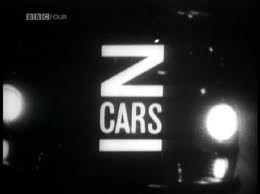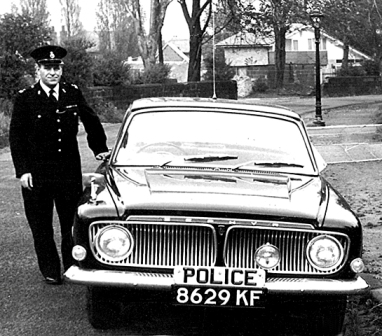Z CARS by shaun rothwell, retired
It was January 1962 just after eight o’clock one Wednesday night as the fife and drum struck up the Liverpool sea shanty JOHNNY TODD and shortly afterwards for the first time, the outside world, heard the phrase “BD TO Z VICTOR ONE”.
The 1960’s were a watershed for British television. “Z-Cars” was a new television series created by the BBC, was set in a mythical place called Newtown and revolved around the activities of the local police and in particular the Crime Patrol; uniformed Officers who patrolled the area in large saloon cars – Ford Consuls in the first series, subsequently replaced by the Ford Zephyr 6.
The show’s main characters, who would soon all become household names, were PC’s Bert Lynch, Jock Weir, Fancy Smith, Detective Sergeant John Watt and Detective Inspector Charles Barlow.
The original idea for a series arose from a book written by Detective Sergeant Bill Prendergast of the Liverpool City Police. His book described his experiences as a detective working the hard-bitten post-war environment of Liverpool. ‘Newtown” was in fact Kirkby, an overspill estate 10 miles east of Liverpool. Some local names such as the East Lancs Road remained whilst others like Seaforth were changed into Seaport, though the majority knew where the series was set. Kirkby was under the jurisdiction of the Lancashire Constabulary**.
Colonel T.E. St Johnston, Lancashire’s Chief Constable, had originally supported the concept of a new “police” television series based and filmed in Lancashire. That support ended abruptly after the Colonel saw a preview of the first episode. He travelled down to London to the Home Office and then onto the BBC in an attempt to have the series stopped, as in his opinion, his Officers did not behave in the way that the show portrayed them. The Colonel lost and show was broadcast.
The television series used light coloured vehicles, white or yellow for better recognition under the television cameras and lighting. In reality Lancashire’s crime patrol vehicles were not just Ford Zephyrs but also Vauxhalls and followed the same range of colours as the average family saloon – green, blue, grey but very rarely white. There were no outward visible signs that they were police patrol cars, and the only give-away, to those in the know, were the twin radio aerials, one mounted on each rear wing, the dim dip headlights and the letter “T” in the middle of the main group of three letters on the registration number. This was an age of the black police patrol car, like the Wolseley, with a police sign fore and aft and a bell. Bill Prendergast’s Liverpool City Police used black Ford Zephyr 6’s as their Traffic Division’s main patrol car.
Where did the call signs Z Victor 1 and Victor 2 come from? – Z was the designation for Lancashire’s Crime patrol vehicles, Victor was the letter of the phonetic alphabet for the Division where the crew/car operated, in this case V Division. 1 or 2 indicated a particular vehicle within the Division, though 1 and 2 were usually reserved for the Sergeants car. in 1974 the newly created Southport Divsion became V Division and for a few months the callsign Z VICTOR 1 was a genuine Lancashire Constabulary callsign.
Lancashire Constabulary was known as an innovator in policing, and the Z-cars (Crime Patrol) were an innovation later to be copied by other forces within the United Kingdom and elsewhere.
Lancashire was the first to use white Traffic Cars and some years later would cover their Traffic vehicles completely in Orange fluorescent tape to increase safety of the vehicles and Officers using them. In the latter part of the 1960’s Lancashire Constabulary would roll out a Ford Anglia, as a new small patrol car, it’s distinctive colour scheme of light blue and white led to it being christened “Panda Car” by Deputy Chief Constable William “Bill” Palfrey.
The TV series spun off other shows such as Softly Softly based on Wyvern, alias Bristol, and Softly Softly Task Force, based somewhere in Essex. Charlie Barlow and John Watt rose up the “ranks” to become Detective Chief Superintendent and Superintendent respectively.
In 1974 the Lancashire Constabulary, the largest provincal Force, was reorganised. Spilt between Cheshire, Cumbria, Greater Manchester and Merseyside. Kirkby would now be part of K Division of Merseyside Police. The image portrayed on screen of Kirkby did not sit well with Knowsley Metropolitan Borough Council and numerous calls were made for the BBC to pull the series. The BBC countered by saying that the series was made in Bristol and had little association with Merseyside. Ironically in the Town Centre of modern day Kirkby is “Newtown Gardens”.
Since 1974 3 Chief Constables of Lancashire have previously been members of Merseyside Police.
The Z-Cars television series ran until 1977 by then it was not the Crime patrol but the activities of the mobile beat Officers driving their Ford Escort “Panda” which was featured. The final scene saw Inspector Bert Lynch closing the electric roller shutters over the front door of Newtown Police Station.
Z-Cars would, like Dixon of Dock Green, fade into Television History.
** There might be those who think this is a little cheeky. The Z Cars was a series about the Lancashire Constabulary when this website is about the Liverpool City Police. OK well Ds Bill Prendergast (Liverpool City Police) was the original Police Advisor to the Series and many of the original scripts were drawn from his experiences.
As a 8 year old I watched the very first episode and my ambition was set. To be a member of The Crime Patrol. Like many a young Scouser I joined the County (Lancashire Constabulary). By the time my probation was complete, and therefore i was eligible to apply to join the Crime Patrol, I was a member of Merseyside Police. Though one night during my probation I was the observer in Z Romeo 6. **



